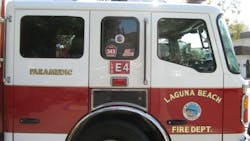CA Crews Make Helicopter Rescue Hours after Training
Laguna Beach firefighters were perched high in the wildland canyons Friday morning, July 19, practicing patient care and evacuation techniques at an area known as Top of the World.
They were joined there by medical personnel, lifeguards, OC Parks Rangers, Mercy Air helicopter and other first responders, all practicing life-saving skills in a city that sees nearly 7 million visitors annually and where helicopter rescues and transports are often the best way to get injured patients to medical facilities quickly.
Just five hours later, those same firefighters — and that same Mercy helicopter with the same nurse and paramedic aboard — put the training into action.
When a woman lying on her back near the base of the stairs at Thousand Steps Beach couldn’t make the steep climb back up the narrow, sand-covered staircase, Laguna Beach firefighters called Mercy Air for assistance. The 32-year-old woman was complaining of severe back pain and the firefighter/paramedics determined the helicopter ambulance was the best way to get her to Mission Hospital in Mission Viejo immediately.
OC Lifeguards, Laguna Beach police and firefighters helped clear a 100-by-100-foot landing zone for the helicopter and in less than eight minutes, the woman was on her way to the hospital.
Since January, there have been nine helicopter rescues in Laguna Beach — two by Mercy Air, five by the Orange County Fire Authority and three by the Orange County Sheriff’s Department.
In 2018, there were 15 helicopter rescues — five by Mercy Air, six by OCFA, three by OCSD and one that included OCFA and OCSD. In 2017, there were 24 helicopter rescue calls.
It’s a year-round need, but rescues by helicopter increase during the summer, as more people visit the beach and wildland areas.
City firefighters request help from OCFA and OCSD helicopters in areas where terrain and access are difficult and emergency crews often must be lowered or dropped in to perform rescues.
Mercy Air, a private air ambulance service, is used in instances where the helicopter can land on a mostly flat surface and can provide immediate air transport to a local hospital.
Emergency rescue by Mercy Air comes at about a $10,000 cost to the patient, some of which is covered by insurance.
During their training, Friday, firefighters got a chance to look inside a Mercy helicopter to familiarize themselves with the process.
“We need to know if we’re bringing patients to the rear or side and we need to know how many patients it can accommodate,” said Pat Cary, a firefighter/paramedic. “If it’s on a pitch we need to move cautiously when approaching it because the rotors are spinning at a rapid speed. When we have a plan to approach, it makes for better patient care.”
First responders also went over the details Mercy Air flight crews need — such as information that will help as they approach the scene. The training concluded with discussions on patient care and what the Mercy crews provide. Each helicopter has a paramedic, a nurse and sometimes a doctor, Cary said.
The Thousand Steps rescue later that day was an example of why the department put its 39 firefighters through the training.
“We had just talked about it and rehearsed it,” Cary said. “When we have these calls (the training) allows us to all be on the same page.”
In recent weeks, there have been two other helicopter rescues at Laguna beaches.
On July 14, an OCFA helicopter flew Javier Vargas Cuellar, 27, of Huntington Beach to Mission Hospital in Mission Viejo after lifeguards found him unresponsive in the ocean. He was pronounced dead at the hospital.
On July 3, OCFA was called after lifeguards found people trapped on rocks at Thousand Steps Beach. At first, firefighters thought they would need to hoist them off the rocks, but ultimately lifeguards were able to get them to safety by accessing the private staircase of a resident.
Still, most calls at Thousand Steps Beach require helicopter rescue, Cary said.
“Typically, at Thousand Steps Beach, we know it’s very difficult to get them up the stairs,” he said. “The access is so difficult and to carry a patient with a back injury is not conducive. There are lots of factors in our decisions — how critical the patient is and what is the best and safest way to get them to care.”
———
©2019 The Orange County Register (Santa Ana, Calif.)
Visit The Orange County Register (Santa Ana, Calif.) at www.ocregister.com
Distributed by Tribune Content Agency, LLC.
